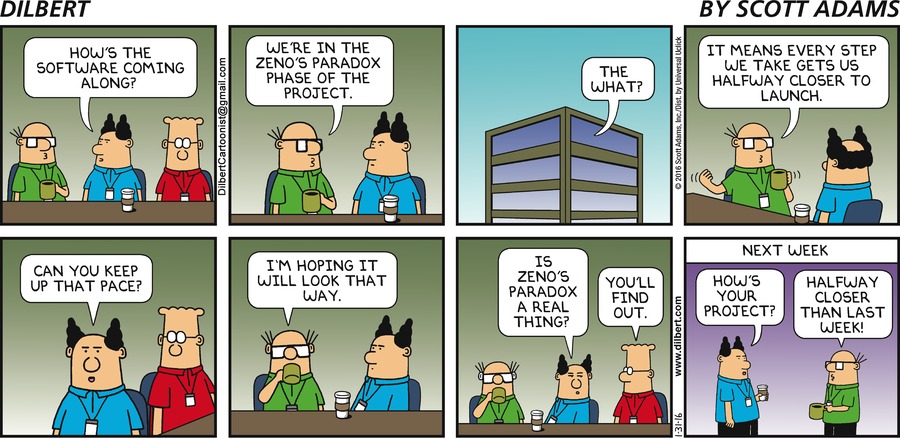Popular culture gets Zeno’s paradox wrong again:

There’s a widespread impression that Zeno’s proposed problem is that after you reach the halfway point to your destination, you then have to go halfway to the remaining distance, and so on ad infinitum, so that you get closer and closer to your goal but never reach it.
But that’s not how the paradox goes. The problem is much worse. The paradox is that before you can get halfway to your destination, you have to get halfway to the halfway point, and so on ad infinitum, so that you can never even start moving. (Here’s Rose Wilder lane making the same mistake.)
Probably the mistake arose from someone conflating this paradox with another of Zeno’s paradox, the Achilles, in which the fastest runner gets closer and closer to catching up to the slowest runner.
of course, the zeno paradox of motion is only a paradox in the world of ancient greek mathematics. In a post-newtonian world, you would say the sum of the infinite series d/2,d/4,d/8,d/16,d/32…converges to the distance d. Using the calculus, you can even demonstrate the finite amount of time to traverse a distance on the set of REAL numbers(and not merely distance on a set of rational ones).
The paradox at play in that cartoon, the one that has not been solved by the calculus, is the iron law of procrastination. The appearance of work being done is merely an illusion…
How can calculus explain the beginning of movement though?
well, that would be physics, with the calculus used as the tool. “Beginning of a motion” is a change in the state of the system. Uniform motion can be transformed away as “at rest” w/ an appropriate coordinate system transformation. A change in the state of the system involves a change in momentum. Analysis of the system has to obey physical laws such as conservation of momentum. Given the change in momentum, the physical constraints the system must obey, solve the differential equations of motion. Note: velocity is dX/dT, the smaller the interval dX, the correspondingly smaller the time interval gets. If you want to think of it in terms of zeno’s formulation, the infinite number of 1/2 intervals to traverse is offset by the increasingly short amount of time needed to traverse the intervals.